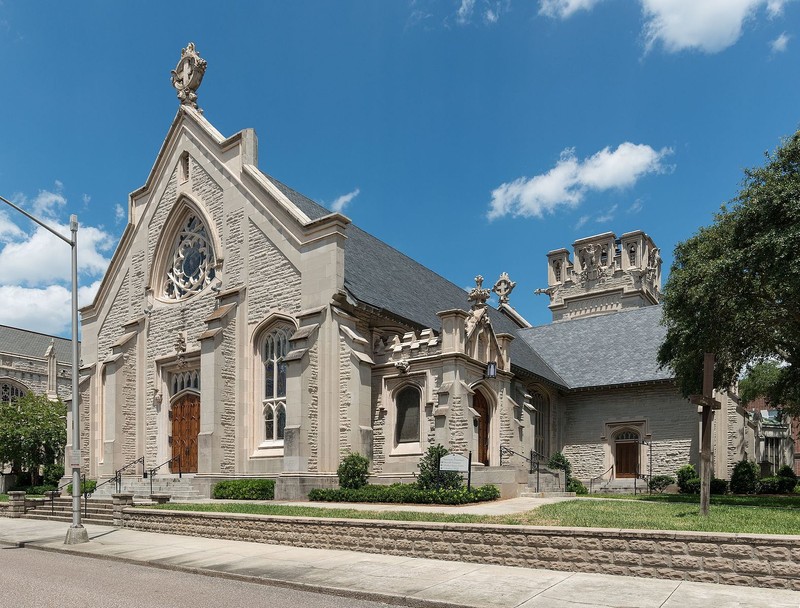St. John's Cathedral
Introduction
Text-to-speech Audio
Images
Front view of St. John's Cathedral

Backstory and Context
Text-to-speech Audio
The Anglican Communion began in the United States when commodore John Hawkins sailed his English fleet onto the St. Johns River in 1565. There, services were read from the Book of Common Prayer on one of his decks, marking the first Anglican worship service in the continental U.S. It was not until 1829, however, that regular services developed. On April 15 of that year, a St. Augustine missionary named Reverend R.A. Henderson made his way into Jacksonville, Florida to hold the first Episcopal services in town. Because it was a new parish, services were held outdoors, but Henderson wrote of the possibility of a church being constructed in the location. The first of its kind in the state, the parish was officially organized in 1834, when members of the church’s community gathered for meetings in individual’s homes, then in the county courthouse.
The first construction of St. John’s Cathedral began in 1842 on Billy Goat Hill, which was the highest point of land in the city. However, it was difficult for the church to gather the funds necessary to complete the building. Women sold tea and baked goods, while also offering various sewing services. It was not until nine years later, though, that the church was finally dedicated in 1851. Yet, the church did not last long. During the Civil War, in 1863, Federal troops burned the building to the ground, the same year Union troops did the same to the nearby Basilica of the Immaculate Conception. The only thing left of the church was the alter prayer book with the cover reading “St. John’s Episcopal Church, Jacksonville,” but the book was not returned until three years after the fire. A Federal medical officer named Dr. Alfred Walton ran into the burning building and retrieved the book; later on, he made the decision to bring it back to its original home.
After the fire and Civil War, services continued to be held in a wooden building referred to as “The Shack.” In 1870, the vestry approved plans for a new 800-person church to be built of brick and granite, and the first services were held there on Easter Sunday in 1877. However, the church later became the victim to catastrophic fire once more. The Great Fire of 1901 destroyed most of downtown Jacksonville, burying St. John’s Cathedral with it, despite the precautions that were taken with fire-resistant building materials such as brick. In 1906, the church community again built a wooden chapel, followed by the present-day cathedral, on the foundation of the former church structure. This time, the building was constructed in a Gothic Revival style of Indiana limestone.
In 1951, Right Reverend Frank Alexander Juhan officially designated St. John’s as the first cathedral of the Diocese of Florida. The designation of the cathedral, coming from the Latin cathedra, meaning “bishop’s chair,” is important to the church, as it houses the chair of the Episcopal bishop of the Diocese of Florida in its chancel. St. John’s Cathedral is also part of the Cathedral District in Jacksonville, which encompasses 118 acres across a 36-block area. It contains five historic houses of worship; aside from St. John’s, they are the First Presbyterian Church, First United Methodist Church, the Basilica of the Immaculate Conception, and the Historic Mt. Zion A.M.E.
Today, the church is host to several programs. Not only did members of the church community begin the Episcopal High School, but they also have a meals-on-wheels program to feed elderly and homeless people in the community. Additionally, the Cathedral Arts Project aims to bring art, dance, and music to disadvantaged children. St. John’s Cathedral also creates houses for people in need.
Sources
- St. John's Cathedral, The Episcopal Diocese of Florida. Accessed September 27th 2020. https://www.diocesefl.org/about-us/the-diocese/our-cathedral.aspx.
- The History of St. John's Cathedral, JAX Cathedral. Accessed September 27th 2020. https://www.jaxcathedral.org/uploads/files/history-of-sjc_5.pdf.
- St. John's Cathedral 1 Jacksonville, FL, University of North Florida. October 11th 2008. Accessed September 27th 2020. https://digitalcommons.unf.edu/historical_architecture_main/1211/.
- About the Cathedral District, Cathedral District. Accessed September 27th 2020. https://cathedraldistrict-jax.org/about/.
https://commons.wikimedia.org/wiki/File:St._John%27s_Cathedral,_Jacksonville_FL,_West_view_20160706_1.jpg
